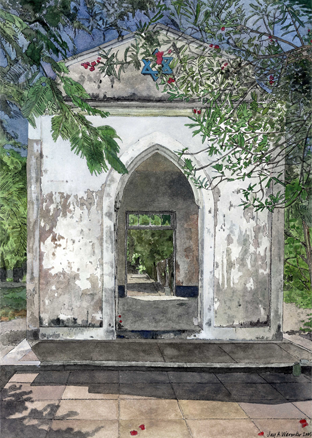
Exterior View (2005), 11” x 15” Watercolor, Jay A. Waronker
MOZAMBIQUE
Tara (or Tahara) House (Dating to the Early 20th Century) |
|
|
During the first dozen years of the 20th century, the exact date unknown, the Portuguese authorities acceded to a request of the local Jewish community and granted them a plot of land for a cemetery. Located in the Alto Mae section of Maputo northeast of the central business district and away from the coastline, it is today adjacent to a much larger Muslim cemetery and the even more sizeable St. Xavier Catholic Cemetery directly across the street. The cemetery, narrow and long and measuring 72’ wide x 257’ deep, is approached from the secondary street fronting the property along its short side that is marked by a masonry and stucco wall with engaged pilasters and painted blue Stars of David. These features were added in the early 1990s to the older wall. A painted iron gate added at the same time that is also decorated with Stars of David opens onto a concrete path that bisects the cemetery into two nearly equal zones.
Towards the front of the cemetery, placed just off center of the path and property, is a tiny early twentieth century ohel, or chapel. Referred to as Tara (or Tahara) House by the local Jewish community, its exact date of construction is unknown. Yet according to recorded history, it was realized before a site for the synagogue was purchased in 1921. Measuring 14’-6” x 21’-6”, for decades the chapel was used exclusively by the Jewish community. The open-air structure, finished in buff-colored stucco, features a front pediment with a blue Star of David and front and rear openings with pointed arches. Behind this chapel are all the Jewish graves.
In the 1920s, the Jewish cemetery was looked after by an Indian watchman. Over the years, various caretakers assumed control although there were periods, particularly during the years of civil war in Mozambique beginning in the mid-1970s and continuing well into the 1980s, when the cemetery was unattended to and became overgrown, derelict, and was vandalized. Since the early 1990s, the property has been tended to by an older African man who does his best to watch over the site. In 1992, at a time when the cemetery had essentially been transposed into a garage dump and homeless refuge, a cleanup up effort was carried out. The property walls were raised, tombstones repaired and re-erected, and tons of refuse removed. Water was piped in and trees, grass, and flowers were planted.
Today Maputo’s Jewish cemetery grounds are in adequate, albeit not pristine condition. The curbed path running from the street along the entire length of the property, essentially bisecting the cemetery, was once lined with small trees forming a formal processional axis. Some of this vegetation is now missing. While not overgrown, the grounds are scraggily and not manicured, and the chapel is in less than perfect condition. Nevertheless, the place is appealing and peaceful. Any observant visitor will take note of the positioning of the rows of headstones flanking the central path. Each side faces the walk, which is not in keeping with the Jewish tradition of any headstone being positioned closest to Jerusalem.
The majority of tombstones indicate burials dating to the first half of the twentieth century, although there is record of a Jewish funeral in Lourenço Marques as early as 1873 before this cemetery was founded. A large number of deaths occurred among the members of the Jewish community during the years of World War I. In those days all goods, including medicines, were imported from England and there was consequently an acute shortage of quinine in this mosquito-infested region during the period when shipping was completely disrupted by the U-boat menace. Other tombstones date from the years leading up to and after World War II. There is also a scattering of graves incised with dates of deaths continuing into the 1950s, 60s, and 70s. A few Jews have also been buried here in the last couple of decades. Altogether at the time of this painting, the cemetery was home to sixty-three marked graves with headstones legibly inscribed in Hebrew, English, Portuguese, or a combination of these languages.
